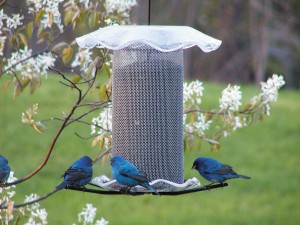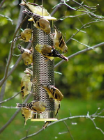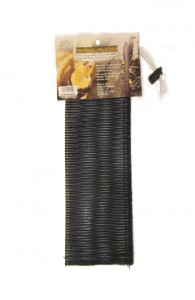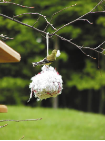-
See More Species with a Finch Bird Feeder

Feeding thistle or nyjer seed will attract more than Goldfinches!
The high fat and protein content found in thistle makes it wildly popular among both House and Purple Finches, Towhees, Pine Siskins, Juncos, and Indigo Buntings (shown above). This makes the Finch Bird Feeder highly versatile and a pleasure to watch. Another great benefit of this feeder is that seed won’t germinate, so there’s no worries of unsightly weeds below your feeder.
Mixing thistle seed with finely chopped sunflower kernels also helps reduce the mess below feeders. Pine Siskins and other prefer the mix as well. Finch feeders have special ports for thistle, they are generally much smaller than those of other wild bird feeders. There are tons of finch bird feeders on the market, one to suit your tastes and environment shouldn’t be too hard to find!
-
Crowded Thistle Bird Feeder?
 If finches are flocking to your thistle bird feeder in droves, it may be time to add more feeders! Not the same tube type feeders, but inexpensive thistle socks, made of mesh with a simple drawstring closure. They are highly effective at giving finches their “needed” space to feed.
If finches are flocking to your thistle bird feeder in droves, it may be time to add more feeders! Not the same tube type feeders, but inexpensive thistle socks, made of mesh with a simple drawstring closure. They are highly effective at giving finches their “needed” space to feed.Since the socks, or sack is mesh, the whole surface offers feeding space. They do not have to be cleaned, and are meant to be disposable after they become worn and tattered. You can get hundreds of feeders from just one thistle sock.
Goldfinches, unlike other birds, are non-aggressive around feeders. Instaed of fighting for food, they are apt to just give up. So by adding another thistle bird feeder or two, you can accommodate more Goldfinches inexpensively, and effectively!

- Bird Accessories, Bird Feeders, Nesting Material, Thistle Feeders, Tube Bird Feeder, Uncategorized, Wild Bird Feeders
Add Nesting Material Near Thistle Bird Feeders
 If you enjoy goldfinches and happen to feed thistle or nyjer seed to attract them, there’s more you can do to accommodate these little songbirds. Adding nesting material near your thistle bird feeders will entice them to nest nearby. This means a good chnace of seeing more finches and especially fledglings. Although Goldfinches don’t use birdhouses, they will nest in hedges or trees. They are the latest songbird to nest and breed with their season running from June to September. (So there’s still time).
If you enjoy goldfinches and happen to feed thistle or nyjer seed to attract them, there’s more you can do to accommodate these little songbirds. Adding nesting material near your thistle bird feeders will entice them to nest nearby. This means a good chnace of seeing more finches and especially fledglings. Although Goldfinches don’t use birdhouses, they will nest in hedges or trees. They are the latest songbird to nest and breed with their season running from June to September. (So there’s still time).The House Finch, who also feasts at thistle feeders, has 1 to 3 broods per year, so they stay pretty busy building their nests – which can be found just about anywhere. Check the Boston Ferns on your front porch before drenching them with water!
Commercial nesting materials are available, but you can make your own fairly easily. Using a mesh bag (from the produce section of the grocery store) start collecting dryer lint, yarn strings, pet hair, moss, and small twigs. Gather materials and tie off bag to hang from a tree branch. Your birds will be grateful for the easy pickings!

